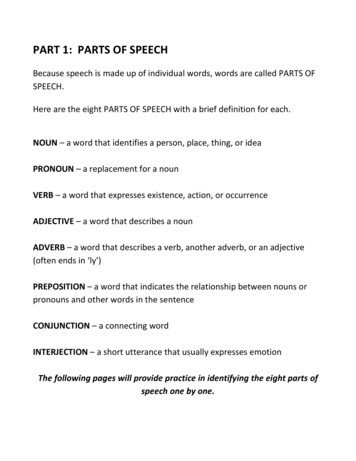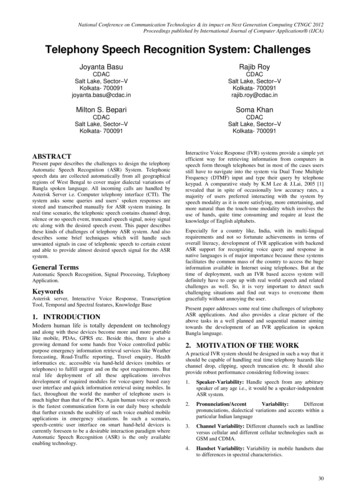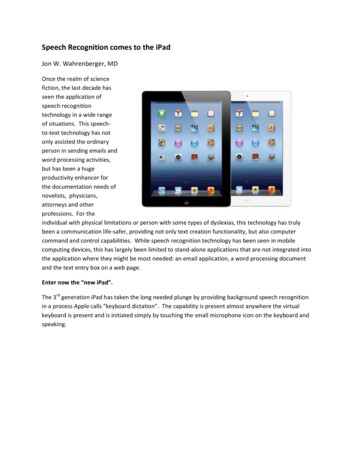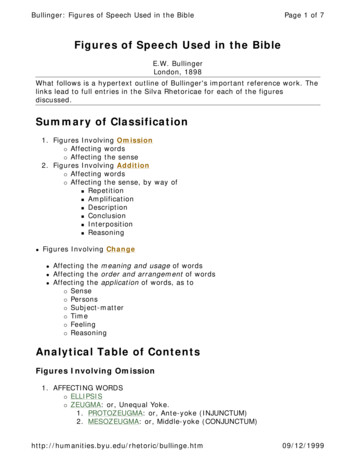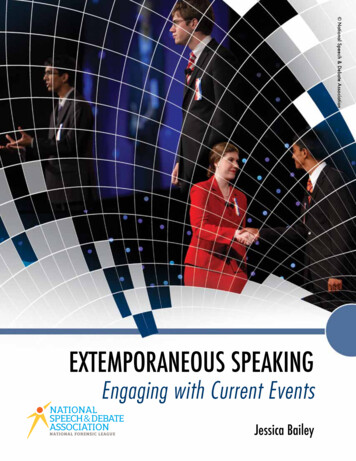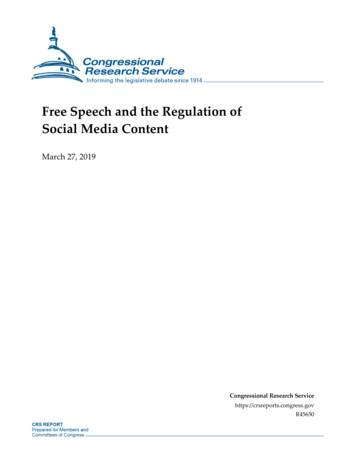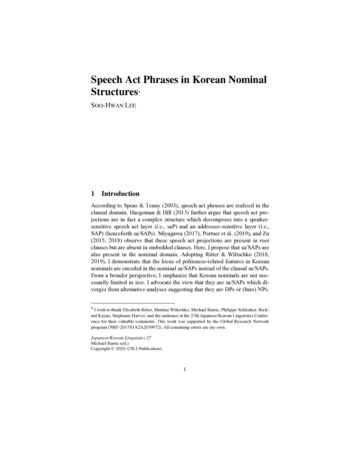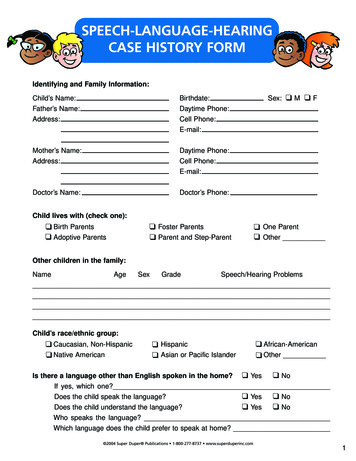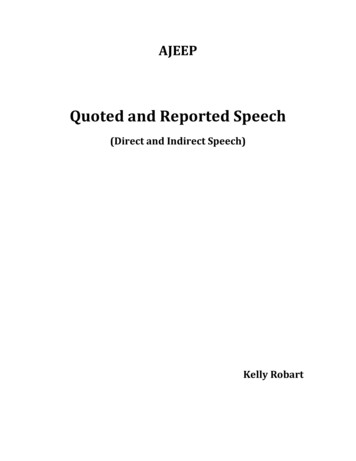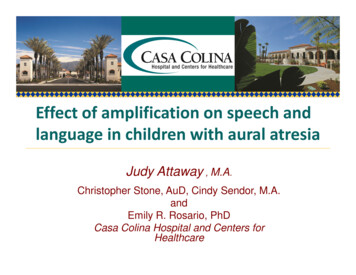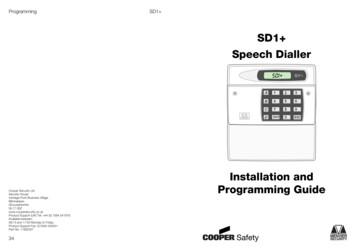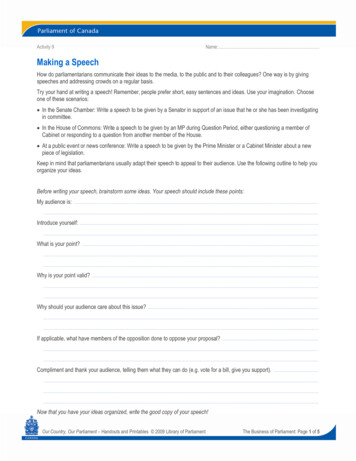
Transcription
Activity 9Name: .Making a SpeechHow do parliamentarians communicate their ideas to the media, to the public and to their colleagues? One way is by givingspeeches and addressing crowds on a regular basis.Try your hand at writing a speech! Remember, people prefer short, easy sentences and ideas. Use your imagination. Chooseone of these scenarios: In the Senate Chamber: Write a speech to be given by a Senator in support of an issue that he or she has been investigatingin committee. In the House of Commons: Write a speech to be given by an MP during Question Period, either questioning a member ofCabinet or responding to a question from another member of the House. At a public event or news conference: Write a speech to be given by the Prime Minister or a Cabinet Minister about a newpiece of legislation.Keep in mind that parliamentarians usually adapt their speech to appeal to their audience. Use the following outline to help youorganize your ideas.Before writing your speech, brainstorm some ideas. Your speech should include these points:My audience is: .Introduce yourself: .What is your point? .Why is your point valid? .Why should your audience care about this issue? .If applicable, what have members of the opposition done to oppose your proposal? .Compliment and thank your audience, telling them what they can do (e.g. vote for a bill, give you support). .Now that you have your ideas organized, write the good copy of your speech!Our Country, Our Parliament – Handouts and Printables 2009 Library of ParliamentThe Business of Parliament: Page 1 of 5
Activity 10Name: .In the House: Game QuestionsThese questions are drawn from Section 3: Canada’s Democracy in Action and Section 4: The Business of Parliament of OurCanada, Our Parliament and are specifically related to the careers of Members of Parliament.1.According to the Constitution Act, national elections must be held at least once every two years. FALSE2.Canada is divided into a number of electoral districts or constituencies called ridings. TRUE3.People running in an election who do not belong to a party are called unassociated candidates. FALSE4.On Election Day, the candidate who gets the most votes in a riding wins and becomes that riding’sMember of Parliament. TRUE5.The political party with the most elected MPs usually forms the Government. TRUE6.The leader of the party in power and the Head of Government is called the Prime Minister. TRUE7.The number of ridings has remained the same since Confederation. FALSE8.If a majority of MPs vote to defeat the Government in the House of Commons on a vote of confidence, Parliament isusually dissolved and an election is held. TRUE9.During an election campaign, candidates are not allowed to put up campaign signs or canvass door-to-door. FALSE10. Candidates may spend as much money as they want during a campaign. FALSE11. Youth are allowed to help out candidates during campaigns. TRUE12. Canada has many different political parties. TRUE13. To vote in a federal election, you must be a Canadian citizen and at least 21 years of age. FALSE14. To vote in a federal election, you must publicly announce for whom you want to vote. FALSE15. The only way to vote is by going to a polling station on Election Day. FALSE16. The Members of Parliament who do not belong to parties that form the Government are called Opposition MPs. TRUE17. The Official Opposition is usually the party with the second most elected members after the winning party. TRUE18. Canada has a bicameral parliamentary system, meaning there are two separate Chambers: the Senate for Senatorsand the House of Commons for Members of Parliament. TRUE19. When MPs meet in the House of Commons in Ottawa, it is said that the House is in session or is sitting. TRUE20. The governing party sits to the left of the Speaker of the House of Commons. FALSE21. Only Senators take part in question period, a daily period of time during which parliamentarians ask the Governmentquestions about its activities or important issues. FALSE22. Opposition MPs are not allowed to introduce new bills. FALSE23. The first and only female Speaker of the House of Commons was the Right Honourable Jeanne Sauvé. TRUE24. The House of Commons has a red carpet to represent Canada. FALSEOur Country, Our Parliament – Handouts and Printables 2009 Library of ParliamentThe Business of Parliament: Page 2 of 5
Activity # 11bName: .In the House: Game Point CardsPrint and cut out these cards.The Prime Ministerbriefs you on a newpolicy direction.You rehearsequestion periodmaterials withyour staff.You find time toanswer a few letters.Your assistant bringsyou a sandwich.You find your missingbinder in your desk.WIN 3 POINTSWIN 1 POINTWIN 2 POINTSWIN 1 POINTWIN 1 POINTYour assistant tradesyour Thursday afternoonHouse duty with anotherMP; you can take anearlier flight home.You make it safelyhome and your kidsare still awake to saygoodnight!Your Committeemeeting runs late andyou miss lunch.One of your staff callsin sick.The party whip callsto make sure you’ll bein the House thisafternoon.WIN 3 POINTSWIN 2 POINTSWIN 0 POINTSWIN 0 POINTSWIN 0 POINTSA breaking newsstory changes yourquestion period strategy.You form a new strategywith your staff.You draw House duty ona Thursday afternoon andhave to miss a lunch withfriends.You attendthree differentreceptions―at thesame time!You misplace all yourcorrespondence forthe day.You spill coffee on yourBlackberry and lose allyour contact numbersand schedulinginformation.WIN 0 POINTSWIN 0 POINTSWIN 0 POINTSWIN 0 POINTSWIN 0 POINTSA snowstorm delaysyour flight home.You are asked by thePrime Minister to jointhe Cabinet.Your party wins theelection.You are invited as aguest of honour to acelebration in yourriding.You propose a billthat passes.WIN 0 POINTSWIN 3 POINTSWIN 2 POINTSWIN 1 POINTWIN 2 POINTSThe budget passessuccessfully!You are elected asSpeaker of the Houseof Commons.You are praised inyour riding’snewspaper for yourgreat work!The Prime Ministerinvites you to lunch.You are selected tosit on a committeeyou want to join.WIN 1 POINTWIN 2 POINTSWIN 3 POINTSWIN 2 POINTSWIN 3 POINTSOur Country, Our Parliament – Handouts and Printables 2009 Library of ParliamentThe Business of Parliament: Page 3 of 5
Activity 11aName: .Bill on the HillCut out the steps for passing a bill and re-arrange them in the correct order. Glue the steps in the correct order on a blanksheet of paper and show how each step is connected using arrows.A parliamentarianhas a good ideaand writes it downto become theGood Idea Bill.The changed GoodIdea Bill C has itsThird Reading.The Good IdeaBill C goes to theSenate, where itgoes through asimilar legislativeprocess(Introduction andFirst Reading,Second Reading,Committee Stage,Report Stage,Third Reading),and passes.The Committeereports on the GoodIdea Bill C.Changes to thebill are consideredand voted on.The Good IdeaBill receives RoyalAssent from theGovernor General.The Good IdeaBill C goes tocommittee, whereit is examined lineby line.The Good IdeaBill C passes in theHouse of Commons!The Good IdeaBill is introduced(First Reading) inthe House ofCommons, printedand given a numberthat starts with a C.The Good IdeaBill is now theGood Idea Law.The Good IdeaBill C has itsSecond Reading,during which it isdebated and votedon in principle.Note: If the bill was introduced in the Senate, it would be given the letter S followed by a number.Our Country, Our Parliament – Handouts and Printables 2009 Library of ParliamentThe Business of Parliament: Page 4 of 5
Activity 11bName: .Make it LawMy bill: .Why is this idea good for Canadians?1. .2. .3. .Are there any reasons this idea might be difficult to pass?1. .2. .3. .Does this bill fit with the rights and freedoms in the Canadian Charter of Rights and Freedoms? .What extra information would help me better understand this idea? .
3. People running in an election who do not belong to a party are called unassociated candidates. FALSE 4. On Election Day, the candidate who gets the most votes in a riding wins and becomes that riding’s Member of Parliament. TRUE 5. The political party with the most elected MPs usually forms the Government. TRUE 6. The leader of the party in power and the Head of Government is called the

